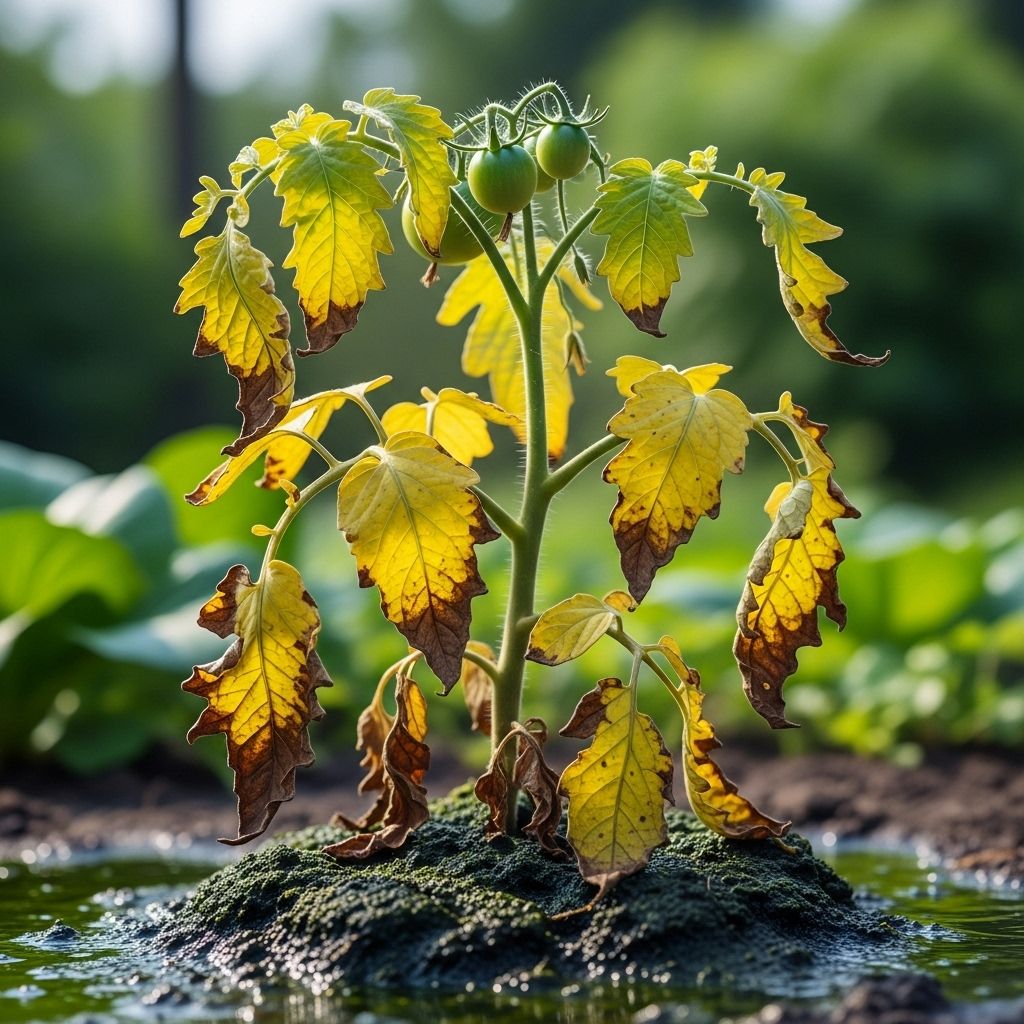Overwatering Tomatoes: 7 Signs And How To Save Your Plants
Identify the signs of overwatering tomato plants and learn essential steps to restore their health and maximize your harvest.

Image: HearthJunction Design Team
7 Signs of Overwatering Tomatoes and How to Save Your Plants
Even though tomatoes (Solanum lycopersicum) are known for their love of water and consistently moist soil, giving them too much water can quickly result in a host of problems, threatening your summer harvest. Learning to spot the warning signs of overwatering early can save your plants from long-term damage and help you produce bountiful, healthy fruit through the season.
Contents
- Introduction to Tomato Watering Needs
- 7 Signs of Overwatering Tomatoes
- Common Causes of Overwatering
- How to Save Overwatered Tomato Plants
- Best Practices for Watering Tomatoes
- Frequently Asked Questions (FAQs)
Introduction to Tomato Watering Needs
Tomatoes are notorious for their “Goldilocks” requirements: they need just the right amount of water—not too little, not too much. The challenge often comes from the mistaken belief that more water always equals better growth. In reality, overwatering is one of the most common mistakes among home gardeners and can be just as damaging as underwatering.
Plants suffering from excess moisture can develop diseases, experience stunted growth, and may even die if the issue persists. Striking the appropriate balance—moist but not waterlogged soil—is the key to strong roots and vigorous fruiting.
7 Signs You’re Overwatering Tomatoes
Recognizing the early warning signs of overwatering is essential to prevent irreversible damage. Here are the seven main symptoms to watch for in your tomato plants:
1. Waterlogged Soil
Before examining leaves or fruit, always check the soil. Water that pools around the base of your plants, or soil that feels soggy well after watering, is a red flag for waterlogging. Roots submerged in overly wet soil may begin to rot, quickly undermining your plant’s health. Excessive rain or poor drainage can also be to blame, especially if your tomatoes are in low spots or heavy clay soil.
- Standing water around the stem.
- Soil that doesn’t dry out between waterings.
2. Yellowing Leaves
Yellowing leaves—especially the lower ones—are a classic sign of overwatering. Though nutrient deficiencies or natural leaf aging can also cause yellowing, water stress is often the culprit when the soil is consistently wet. Overwatered roots are unable to absorb nutrients efficiently, resulting in an overall pale or yellow look.
- Lower leaves turn yellow first.
- Yellowing often spreads upward if unchecked.
3. Wilting Despite Wet Soil
It’s counterintuitive, but leaves that droop or wilt—even when the soil feels moist—can signal root damage from too much water. Healthy roots need oxygen as much as moisture; waterlogged conditions suffocate roots, preventing them from taking up water, which paradoxically results in wilting similar to underwatering.
- Wilting is present even after recent watering.
- Soil feels cool and soggy to the touch.
4. Blisters or Lesions on Stems and Leaves
Excess moisture can cause the development of blisters, bumps, or water-soaked lesions, particularly on stems and the undersides of leaves. When roots are stressed, the plant struggles to regulate water, resulting in these visible injuries.
- Blisters or darkened, mushy patches.
- Stems may appear swollen or cracked.
5. Fungal Disease Outbreaks
Fungi flourish in wet environments, and overwatered tomatoes are far more susceptible to a range of diseases, including powdery mildew, early blight, and root rot. Keep an eye out for fuzzy white growth, dark spots, or sudden collapse of otherwise healthy stems.
- Gray, white, or black spots on leaves or fruit.
- Unusual mold or mildew along the soil line.
6. Cracked or Split Fruit
Tomato plants regulate the transfer of water to their fruit, but sudden surges in soil moisture can overwhelm the skin of ripening tomatoes, causing them to crack or split. While some cracking is weather-related, repeated overwatering is a frequent offender.
- Fruit develops radial or concentric cracks.
- Cracks often deepen after heavy rain or watering.
7. Poor Growth and Reduced Yield
Overwatered tomatoes often exhibit stunted or slow growth. Roots damaged by excess moisture cannot support healthy foliage or fruit development, resulting in fewer flowers, smaller fruit, and a disappointing harvest.
- Plants appear small or fail to thrive.
- Low fruit set or undersized tomatoes.
Common Causes of Overwatering
Understanding how overwatering happens is the first step to prevention. Common causes include:
- Frequent shallow watering: Watering too often or only lightly saturates the upper soil, encouraging shallow, vulnerable roots.
- Poorly draining soil: Heavy clay or compacted soils don’t allow excess water to move away from roots.
- Excessive rainfall: Spring and summer downpours can quickly overwhelm garden beds.
- Containers without drainage: Pots or grow bags without adequate drain holes trap water at the root zone.
- Automated irrigation: Drip or sprinkler systems set to run too frequently can oversaturate the area.
How to Save Overwatered Tomato Plants
If you suspect your tomatoes are suffering from too much water, there are several steps you can take to rescue them and prevent future issues:
- Pause Watering: First, allow the soil to dry out before your next watering. Check with your finger—don’t add more water until the top 1–2 inches are dry.
- Improve Drainage: Amend heavy soils with compost or organic matter to increase porosity. For raised beds or containers, ensure there are plenty of drainage holes.
- Relocate as Needed: If tomatoes are in persistently soggy ground, transplanting to raised beds or moveable pots may help.
- Mulch Wisely: Apply a thin layer of mulch once the soil is moist—not wet—to help retain the right amount of moisture, preventing future extremes.
- Remove Damaged Growth: Trim any yellow, moldy, or blistered leaves with sterile tools to reduce disease risk and redirect energy into healthy regrowth.
- Combat Fungal Outbreaks: Use organic fungicides if necessary and remove all infected plant material immediately.
- Monitor Soil Regularly: Invest in a moisture meter or simply check with your finger before each watering to maintain the ideal balance.
Best Practices for Watering Tomatoes
Correct watering is crucial for tomato success. Here are expert recommendations to ensure your plants get just what they need:
- Water deeply but infrequently: Aim for a thorough soaking once or twice a week, rather than daily light sprinkling.
- Target the base: Always water at soil level, not on the leaves or stems, to avoid spreading disease.
- Morning is best: Water early so plants can absorb moisture before the heat of the day and foliage can dry off quickly.
- Mulch for moisture control: An organic mulch retains moisture and regulates temperature in the root zone.
- Adjust for weather: Water less during rainy spells and more during hot, dry weather.
Watering Methods Compared
| Method | Pros | Cons |
|---|---|---|
| Sprinkler | Quick for large areas | Promotes disease, inefficient, wets foliage |
| Watering Can | Easy for small gardens, precise | Labor-intensive for larger areas |
| Soaker Hose/Drip Irrigation | Best for deep, consistent watering; keeps foliage dry | Initial setup required |
Frequently Asked Questions (FAQs)
Q: How do I know if my tomato plant is overwatered or underwatered?
A: Overwatered plants often show yellow leaves, wilting despite wet soil, and soggy roots, while underwatered plants wilt with dry soil and may have crispy, brown edges on leaves.
Q: Will overwatered tomato plants recover?
A: Many overwatered tomato plants can recover if the cause is corrected early. Letting the soil dry out and improving drainage are critical first steps to recovery.
Q: What is the ideal soil moisture for tomatoes?
A: Tomatoes thrive in consistently moist but not waterlogged soil. The top 1 to 2 inches of soil should dry slightly before the next watering.
Q: How can I avoid overwatering tomatoes in containers?
A: Use pots with adequate drainage holes, check soil moisture frequently, and only water when the soil has begun to dry out to at least an inch deep.
Q: Is rainwater better for tomato plants?
A: Rainwater is excellent for tomatoes, as it is soft and free of salts, but excessive rainfall still requires monitoring to prevent waterlogging or root rot.
Conclusion
Overwatering tomato plants is a common but avoidable problem that can lead to stunted growth, yellowing leaves, disease, and even crop failure. By recognizing the key signs, adjusting your watering routine, and maintaining healthy soil, you’ll set your tomato plants up for a robust and productive season. Remember: consistent observation and responsive gardening are your best tools for keeping your tomatoes thriving all summer long.
References
Read full bio of Srija Burman












